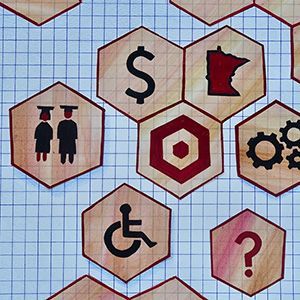cover story one
A Crisis in Home Health Direct Care
The Minnesota Solutions Model
Jesse Bethke Gomez, MMA
The model of the health care delivery system in the United States has hospitals, clinics and specialty medical services on one side. On the other side are home health direct-care services, along with community-based services. The home health side is facing a complex crisis at the heart of which are personal care assistants (PCAs). Among other concerns, for individuals who rely upon PCAs for daily living, there is more demand than supply. There are not enough adequately trained PCAs to meet existing needs and growing demands.
cover story two
The MN 2035 Plan: Improving Public Health
By THOMAS E. KOTTKE, MD, AND CLARENCE JONES
Despite unprecedented and exponentially expanding advances in medical science, health care status in the United States is becoming exponentially worse. After decades of declining mortality from cardiovascular disease, the Journal of the American College of Cardiology reports that in the first 18 years of the 21st century cardiovascular health declined by greater than 10% for the overall American population. Much of the decline in cardiovascular health is due to increasing rates of obesity and Type 2 diabetes. A national multi-center study suggests the number of Type 2 diabetes cases among youth in the U.S. nearly doubled between 2001 and 2017. Diabetes prevalence, showing similar trends in Minnesota, has increased over the past two decades to a record high in 2020.
Rural Health
Improving Rural Mental Health Care: Upstream and Downstream Solutions
By David Beard, PhD, Zomi Bloom, MBA, and Chance Lasher
When a patient presents with a mental health issue, the physician’s biggest challenge can be connecting the patient to the help needed. The patient may seem engaged and thankful for the referral, but this enthusiasm can vanish quickly. The patient may never make an appointment, or may make an appointment and become a no-show. For patients living in greater Minnesota, lack of mental health provider options and greater travel times can exacerbate these concerns.
Interview
Providing a True Continuum of Care
Kimber Wraalstad, MHA, Administrator/CEO at Cook County North Shore Hospital and Care Center
Specialty Care
Orthopedic Care for Older Adults: A New Calculus
By Sarah Anderson, MD, and Mai Nguyen, MD
Orthopedic surgery continues to change at a great pace. Improved implants provide an increased range of motion with enhanced stability and durability. Minimally invasive techniques lessen soft-tissue damage for expeditious discharge and rehabilitation. Going forward, computer-assisted surgery is poised to help ensure reproducible and accurate placement of implants.












